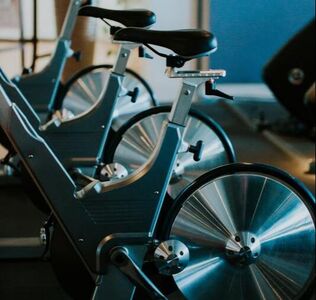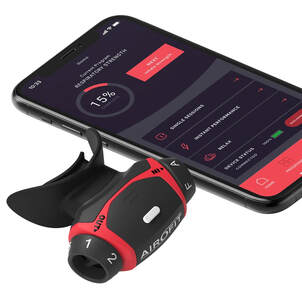The Pyramid Of Breathing Performance For Hikers (If You Get Out Of Breath Hiking Up Hills)4/20/2021
Do you always get huffed and puffed when hiking up hills? Do you struggle to carry a conversation when going up an incline on the trail? Does your heart rate go through the roof the second you are walking on any elevation? If you said yes to any of those questions, this article is for you. One of the most common issues I hear from hikers is they are fine on the flat, have no problem on the descents, but the second they start hiking up a small amount of incline, they turn into a red-faced, sweating, huffing and puffing mess. And if this is you, don't feel bad. Because you are not alone! But, if you do struggle with getting out of breath when hiking up hills, just know you can make a change to this. And, if you do the right things in your training, you can turn uphill hiking from an absolute ordeal to a walk in the park! And today, I want to share with you my strategy for doing precisely this. Improving Your Breathing When Hiking Up Hills When it comes to improving your breathing performance when hiking up hills, it is all about priorities. There are some areas of training you should spend most of your time, and will give the best benefits. Others may be beneficial but don't really need a tremendous amount of time. And then are some, which are only really worthwhile, if you are already nailing the other sections of your hiking. Unfortunately, many hikers here have their priorities out of whack. And spend way too much time in some areas (such as typical HIIT training). And not nearly enough time on others. Now many different approaches CAN work here. And people have seen success with dozens of different strategies. But today, I am sharing with you the Summit Strength Method, which is the exact method I use with my own training for hiking clients. I know this approach works because I have used it with dozens of hikers to help their uphill hiking. From beginners who are first discovering hiking and slowly building up their day hiking distance. To hardcore mountaineers, who are preparing for some of the tallest mountains in the world. While the details of how you apply this training will vary from person to person, the overarching strategy as a whole is valuable for any hiker who is wanting to improve their breathing when hiking up hills. Introducing, the Pyramid Of Breathing Performance For Hikers: Aerobic Capacity Aerobic capacity is the single most crucial aspect of fitness for any hiker to develop. The aerobic energy system is the system in the body that produces energy while in the presence of oxygen. This is what you use for 95% of your hiking time. And this is where the majority of your training hours should be spent. If you struggle with getting out of breath on hills, developing and training your aerobic capacity is the first place you should look. So how do you do it? Well, it is really simple. Aerobic capacity responds to long-duration, low-intensity exercise. So think hiking, walking, easy jogging, cycling, even swimming. Anything which you can sustain for an extended period of time, without getting out of breath. It may seem a bit backwards for some to focus on low-intensity exercise to improve the trail's higher difficulty sections, but it is 100% necessary. And the better you can develop this, the longer and faster you can hike without relying on your other energy systems (and getting huffed and puffed). So how much of this should a hiker be doing? Well, that is hard to say as this is a VERY individual question. And depending on training history, time availability, type of exercise, and a dozen other factors, it will determine the exact answer. But, if you struggle with getting out of breath on hills, adding an extra session or two of aerobic capacity is always the first place to start. IMPORTANT TIP: Aerobic capacity best responds to volume and not intensity. So if you want to improve this, think about adding in more minutes per session/per week, not simply going faster or harder. Aerobic Power Aerobic power is the highest intensity your body can maintain while still predominantly using your aerobic energy system. Developing and training this is incredibly relevant for uphill hiking. Not only can this help you hike at higher intensities without getting out of breath, but it can also make you much more comfortable when you are getting out of breath (which is just as important!) Aerobic power is best developed through some very particular interval training. This is how I like to do it:
For this workout, the work and rest periods are very intentional and are designed to target this 'aerobic power' specifically. So try your best to stick to them! I would recommend hikers who struggle with their breathing up hills include this type of training once a week. And slowly progress it over time. *For a video demonstration of an aerobic power interval workout, you can check out this article: A Great Interval Training Workout For Hikers Sprint Training Sprint training is any type of interval training where you go absolutely 100% intensity. It doesn't have to mean actually sprinting (i.e. running) but includes any kind of cardio activity where you can go all out. While this type of training has several benefits to energy system development (depending on what kind of work/rest ratio you use), the main benefit this type of training has to uphill hiking is simply exposing your body to super high intensities. This can physically and mentally help you feel much more comfortable when you are working harder. So when you are on these hills, the breathing and discomfort aren't quite as much of an issue. *For this reason, a hiker has a bit more leeway regarding workout structure (compared to the specific work/rest periods described in the aerobic power intervals). So feel free to get creative here. There are countless ways of using sprint training to help in this situation, but one of my favourites is this:
I would recommend hikers include this type of training once a week. Either as a stand-alone session, at the end of a strength session, or the start of an aerobic capacity session. Respiratory Muscle Training *Image credit aerofit.com If you are consistently and diligently working on aerobic capacity, aerobic power and have incorporated some sprint training and STILL struggle with your breathing; you might consider respiratory muscle training. Respiratory muscle training is essentially strength training for your breathing muscles. While your breathing muscles are never the 'limiting factor when it comes to your exercise performance, if you can improve these muscles' strength, everything you do is going to be much easier. *This is pretty much the same way is building strength in your muscles will make hiking easier. With this type of training, the tricky thing is it requires a specific 'respiratory training device', which can effectively load the inspiratory muscles to adapt and get stronger. If you do not have one of these devices, it is likely you won't be able to apply enough load to the respiratory muscles, and the training will not be incredibly effective. Standard options here are 'POWERbreathe' or Aerofit' devices * *An 'elevation mask' or 'training mask' does not do the same thing. *The effective stimulus for this type of training is 3 minutes in the morning, 3 minutes in the evening for 4-6 weeks. So for time commitments, very achievable! As you can see, there is a bit of thought and a bit of a process to best improving your breathing performance for hiking. But if you follow this system, put this information into action and focus your training priorities correctly, you can genuinely make a dramatic difference to your breathing on the trail. And, ultimately, you can turn those steep uphill sections into a walk in the park! Want To Get
|
AuthorRowan is a personal trainer who specialises in training for hiking, trekkers and mountaineers for their bucket list adventures. Archives
July 2024
Categories
All
|
AboutSummit Strength is a personal training for hiking service created specifically to help hikers have the best chance of a safe, enjoyable and successful adventure.
|
Company |
Services |
|
|
© COPYRIGHT 2018. ALL RIGHTS RESERVED.
|
Website Design by My Personal Trainer Website
|








 RSS Feed
RSS Feed
